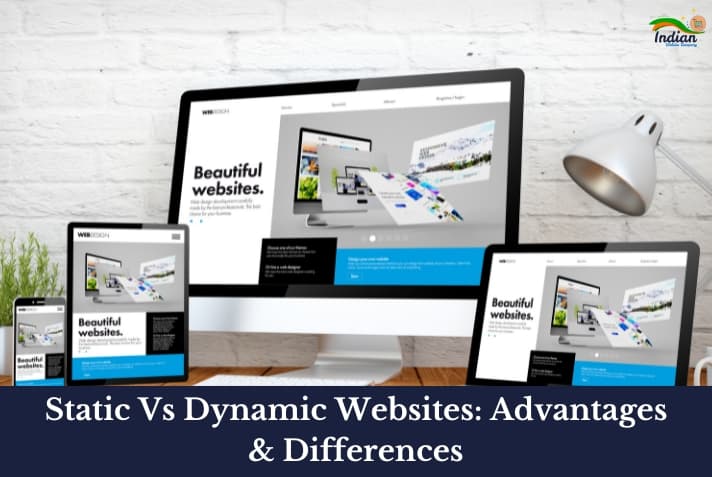Static Vs Dynamic Websites: Advantages & Differences

What is Static Website
Static HTML, CSS, and Javascript-made webpages make up a static website (all examples of web development languages). A static website stores each page as a single HTML file, which is sent directly from the server to the webpage in its entirety. This material effectively merges with your page's design and cannot be changed until the original HTML file is modified at the source code level.
A static website can be manually updated, but only page by page and HTML file by HTML file. For instance, changes made to a homepage's HTML file will only be reflected on the homepage. This holds true even for features like the footer that are consistent throughout the entire website. If you're using a website builder, changes to static pages will be made automatically each time you use the website editor.
Every user receives and views the exact same material on a static site, which is one of its most distinguishing features. Static websites are therefore ideal for smaller websites that don't need frequent updates or adjustments.
A resume website is a suitable contender for a static site. This kind of website doesn't need frequent changes to individual pages or real-time updates based on user activity because each page's content is predetermined. Personal, nonprofit, and solely informative websites are more examples of popular static website types (good examples of these include one-page or landing page sites).
Advantages of static website
We'll discuss some key causes for the return of static sites, at least in some circumstances.
Quicker page load time
A static page's structure prioritises load time, improving browsing efficiency. This sort of site's content is pre-written and served directly from the server, making caching simpler and reducing the likelihood of loading delays or UX problems like broken images.
Static websites typically use fewer server resources and load faster because they don't have to pass through a client server or database infrastructure. Since page load time is an important factor in how Google evaluates a website's performance (and it appears to be playing a more significant role these days).
Rapid creation
When there is a limited amount of time, a static website can be launched more quickly. Since static websites are less difficult and don't need to be connected to databases with organised material, they may be created and published more quickly.
How innovative you want to be with each page design ultimately determines how long it takes for a static site to become live. Dynamic alternatives can still be created quickly, but static pages are typically easier to create and hence deploy more quickly.
The possibility of increased security
Static website pages should theoretically be harder to hack. This is because there are fewer places from which to strike them. We'll clarify:
Static pages don't require external plugins or extensions, which can all be frequent entry points for assaults, nor do they link to a database. In contrast, dynamic websites are not intrinsically risky, but theoretically, a static website is less vulnerable to assault.
Disadvantages of static website
After going over the positives of a static site, let's move on to some of the drawbacks.
A small scalability
One of a static website's biggest drawbacks becomes apparent only with larger, content-heavy designs. A static website can be built with hundreds of pages, but it will always take a long time.
A static website requires that each page be constructed as a distinct entity. You would have to make each page of a website with several pages separately.
Ineffective management
Although static websites can be created more quickly, managing them can take more time. A static website must be edited page by page, which becomes increasingly difficult—and in some circumstances, nearly impossible—as websites are loaded with more content or have content that changes quickly.
What is Dynamic website
A dynamic website is one that changes the type of material that is displayed each time a person accesses it. This display varies depending on the viewer's demographics, the time of day, the location, the language preferences, and other elements.
Dynamic websites provide unique content to viewers each time they visit the site, in contrast to static pages, whose contents must be manually updated before they change. A combination of client-side and server-side scripting is used to accomplish this.
Using scripting languages like JavaScript, client-side scripting entails writing code that is run by the viewer's browser. This scripting is in charge of making adjustments to the homepage in response to user input, such as mouse or keyboard clicks.
On the other hand, server-side scripting refers to code that is run by the server before the material is sent to the viewer's browser. When a webpage is loaded or accessed, such as with login pages, submission forms, and shopping carts, this has an impact. Modern websites may adjust to each user's perspective of the page and take less time to load by using both types of scripting. Additionally, these scripts are more secure, so when you perform network penetration testing, you might detect no or very few flaws in the network.
Popular dynamic website examples include:
Instagram:
Instagram is a social media platform that depends on user-generated content and has a dynamic website.
CNN:
Media organisations update their information on dynamic websites, either in response to breaking news or as stories develop.
Disney Plus
is a sizable streaming platform whose dynamic nature enables its content to be selected and presented in accordance with a user's location, subscription status, and preferences.
Advantages of dynamic website
Dynamic pages are the sole option for many website designers, and for good reason. The following are some benefits of dynamic pages:
Simple to update
Online brand development and business start-up both require consistently updated material. You must keep up with trends, upgrades, and changes in both your industry and your business. The best way to do this is with a dynamic website.
When a page's content is changed on a dynamic website, other pages can be immediately updated without having to change their appearance. This is especially important for websites with a lot of pages because it makes website maintenance more effective.
A dynamic website's ability to be updated quickly and easily is one of its primary features. Your database will be accessible to a number of users, enabling them to administer the website's content without having any influence over the site's structure or design.
Scalability is also made possible by dynamic pages because you can easily and quickly handle thousands of pages. A dynamic website allows you the flexibility to develop when it is essential, even if you don't plan for a large website from the start.
Increased user satisfaction
A dynamic website offers content that is personalised to the user's needs. This can entail modifying the content of the website to reflect their interests, intentions, or prior behaviour on the page, or it might entail presenting information on it based on their location.
In any event, the ability to personalise what visitors see and engage with results in a better user experience. This ability to personalise also increases the likelihood that they'll visit your site again or take additional action, which raises the possibility of conversion.
Greater efficiency
Dynamic pages definitely outperform static pages in terms of utility, yet static pages can also be interactive. Only the complexity of the logic and language required to construct them, as well as the instructions required to provide material, restrict the capability of dynamic pages.
Disadvantages of dynamic website
Performing poorly
Compared to static websites, dynamic websites must execute more instructions. They constantly draw information from a database or content collection that is connected to them in order to show it, which requires processing and execution time. Although many website development tools are aware of this problem and make it a priority to emphasise performance across all pages, it can have an impact on a site's performance.
Expensive
A dynamic website may cost more to maintain than a static website due to tasks like setting up the site's framework, establishing database connections, and adding more features.
When it comes to displaying material on your dynamic website, there may be design and layout restrictions.
Wrapping up
In the end, the choice between a static or dynamic website depends on your specific needs and requirements. Static websites are great for showcasing content that doesn't change frequently, like portfolios or brochure sites. They are typically faster, more secure, and easier to maintain. Dynamic websites, on the other hand, are better suited for applications that require regular updates, user interactions, or complex functionality, such as e-commerce stores or web applications.
If you're unsure which approach is best for your business, the experienced team at Indian Website Company can provide a custom quote and guide you through the process of building the right kind of website for your needs. They have the expertise to help you make an informed decision and deliver a high-quality website solution, whether it's static or dynamic. Don't hesitate to get in touch to discuss your project requirements.
Recent Blogs

CRM Software for Financial Advisory Firms

What are 7 Reasons People Like SEO Services in India?
